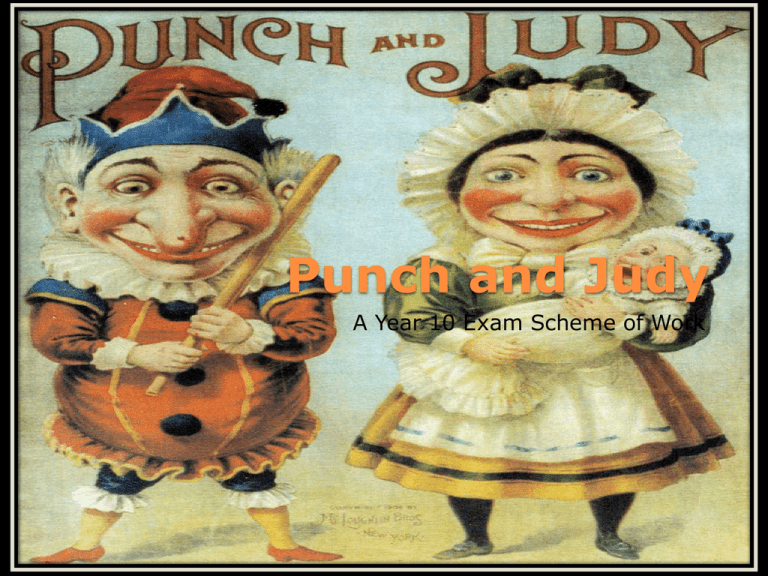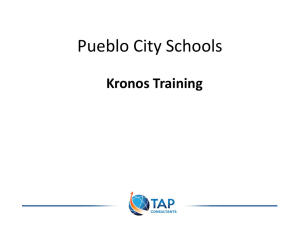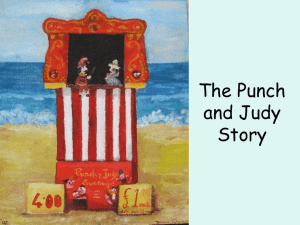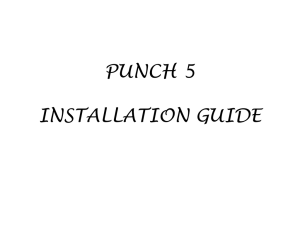Punch and Judy - Malbank School & Sixth Form College
advertisement

Punch and Judy A Year 10 Exam Scheme of Work Lesson One Understanding Unit One Paper One To develop our knowledge and understanding of what is expected of us during Unit One Paper One. WALT MUST listen carefully to the information presented and put all handouts into your drama diaries. SHOULD ask any questions you have regarding your assessment. COULD make additional notes to aid your understanding of the information. WILF This unit requires students to engage in a programme of work that will help them appreciate how a variety of drama activities can be used to deepen their understanding of drama form. Students will learn that it is through practical engagement that understanding might be enriched. The unit requires students to explore a theme, topic or issue through the application of learning from the Programme of Study. Stimuli, chosen by the teacher, will allow students to deepen their understanding of the central aspects of the chosen theme, topic or issue and come to appreciate how the dramatic medium and strategies can be used to create drama form and communicate meaning. INTRO Students will have the opportunity to make connections between different stimuli which support the theme, topic or issue and explore the creative potential of the material. The work produced for this unit is intended to have meaning for the participants and is not intended for performance to a theatre audience. INTRO CONTINUED The process of teaching this unit will be based on the Programme of Study and include sharing work with others and responding to constructive feedback. This will offer students the opportunity to: engage in a range of drama activities explore a range of stimuli chosen across different times and cultures make connections and comparisons between different stimuli. INTRO CONTINUED – AGAIN! Students will participate in a teacher led and teacher supervised six hour practical exploration of drama. The six hours may be conducted in one session or divided into suitable sessions that make up the six hour total. During the practical exploration students should be given the opportunity to work in a variety of different sized groups. The practical exploration will be based on the activities that students have experienced during the Programme of Study and will include: at least two different types of stimuli at least four explorative strategies at least two examples of the drama medium the provision of opportunities to select and use appropriately the elements of drama identified in the Programme of Study. Your assessment Documentary response Students may make notes after the six-hour practical exploration but the final completion of the documentary evidence must take place under supervision. It is recommended that the final preparation of the documentary will take between four and six hours. During the process of completing the documentary evidence the work must not be removed from the centre DOCUMENTARY EVIDENCE Students will produce a documentary response to the work conducted during the six-hour practical exploration that will allude to the process inthe following terms: a reflection on the student’s own work and the work of others an evaluation of the student’s understanding of the explored theme, topic or issue an evaluation of how the use of explorative strategies informed the student’s understanding of the explored theme, topic or issue an evaluation of how the drama medium can contribute to the creation of dramatic form. The response can include any form of suitable documentation, for example drawings, plans, sketches, illustrations, photographs. The documentary response must be no longer than 2000 words. DOCUMENTARY EVIDENCE Lesson Two Punch & Judy – Introduction: non-assessed To respond to the themes of domestic violence and child abuse using the Punch and Judy framework as a structural device. To use the structure to examine the factors behind what makes a man a ‘monster’ and the nature/nurture issue To assess the effect on individuals exposed to domestic violence, child abuse and disability, and how these can have a profound effect on social and personal development. LEARNING OBJECTIVES Development of improvisational skills in the creation and exploration of characters and scenes. Use of technical elements (where appropriate) to aid atmosphere of presentation Use of genres and styles of drama Development of sensitive responses to the issues covered. SKILLS Still-image Role-play Hot-seating Thought-tracking Marking the moment Forum theatre EXPLORATIVE STRATEGIES The use The use The use The use gesture The use of of of of sound and/or music lighting space and/or levels movement, mime and/or of spoken language THE DRAMA MEDIUM Action/plot/content Contrasts Characterisation Conventions Symbols ELEMENTS OF DRAMA To become familiar with the source material To consider the historical and social aspects of the material WALT MUST watch/read all information presented to you today on Punch and Judy. SHOULD present a reaction to the information and discuss opinions. COULD make notes to document your response to support your later coursework. WILF http://www.youtube.com/watch?v=JCGcIwC SCjg&ytsession=JFVCHsqQXan3fhjP8TTqOVvzUWWvGqK8fvCYkTTIusq6hSOGmeZ qo0Q0FFiyCJjCXCi7_JAevMgK4UarwinY9hYPx QkLtBHUghBoIlvD7bzkTlvQ7vdFUydMtmOGfs P776oR2lixDHzLcCrFAtQFp53oeZJWLS7EAenW Mh-dnHwKXzzrqp5bGyIaQEF5RxtXrGDJT_yuNYJsIWSB3IK53xHL3quNdanWRzmGA txA0NbpnwpzwLC9ciBqvCk8njhx-LmyRYuI PUNCH AND JUDY CLIPS Punch and Judy is a puppet show put on by strolling puppet players, especially overChristmas. It came to England in the 17th century but its roots are in Italy and the Commedia dell’Arte character Pulcinella. Punch is a mixture of his Italian character and the stereotypical medieval English fool. He is known for his hunched back, booked nose, chin and pot belly, as well as his cruel behaviour towards his wife, Judy, whom he physically abuses (and in many versions kills). HISTORICAL BACKGROUND Lesson Three Assessed lesson – 1 of 6 To create a starting point for character development To use role-play to explore image stimuli To produce a still-image representation using ideas developed in role work WALT MUST work individually and as part of a team to develop character profiles and still images. SHOULD contribute ideas/suggestions and opinions on the stimulus to develop the drama. COULD support others with the development of ideas through feedback and direction. WILF (Medicine) a grossly malformed and usually nonviable foetus An imaginary creature usually having various human and animal parts A person or animal that is markedly unusual or deformed Someone or something this is abnormally large and powerful A cruel, wicked and inhuman person MONSTER What makes a man a ‘monster?’ If we were all born innocent, what factors affect what we become? You will all be taking the role of a trainee criminal/child psychologist helping the police in their investigation into a murder case. ASSESSMENT In the early hours of the morning of Wednesday September 1st we received a phone call from a Mr Jenkins of Brighton Avenue, who was concerned about a disturbance at his neighbour’s house next door. On arriving at the scene, officers found that there were no signs of life, but on further investigation of the property they discovered the body of a small infant lying on the back ground in the garden. It appeared on first examination that the infant may have fallen from an open window above their heads. Police report Officers then entered the premises by force through the back door. Searching the ground floor area, they discovered the battered and bruised body of a female lying across a settee in the lounge. There were more disturbing finds in the kitchen. The fridge and freezer unit contained a variety of pork sausages and chained to the cooker was a small crocodile. Police report The search was then extended to the top floor of the building. It was here that officers found a locked door, behind which they could hear a male voice repeating: ‘That’s the way to do it.’ Officers prised the door open and it was here they discovered Mr Punch, the owner of the house, and a large wooden club leaning against his chair. Mr Punch was subsequently arrested, and taken to the local station for questioning. Police report In role as child psychologists, you need to study the picture that Punch drew when he was five years old and the family photograph. Make case notes on what the images suggest to them about Punch’s first year of childhood, then discuss their notes with your partner. TASK Punch’s Drawing, Aged 5 Using the discussion and notes generated, each group should create four still images that depict key moments from Punch’s childhood. The images must link in some way to the case notes. Think about: Levels/space Facial expression Body posture/positioning Share images and discuss: What words/phrases do the images suggest? How successful were the individual images (evaluation) PRACTICAL TASKS Note down your involvement in the shaping and development of the images, and the role you played in each image. Make reference to your use of face, body, space and levels and how the notes made in role helped you. Homework Lesson Four Assessed lesson 2 of 6 – Family Values To discuss the impact of nature and nurture on development To use hot-seating to explore and develop roles. WALT MUST take part in the hot seating activity taking a role of a member of Punch’s family and a psychologist. SHOULD make notes of the information and feed them back to the group. COULD make links between the hot seating answers and the themes of nature/nurture. WILF Discussion on ‘family values’. What is nature and nurture? What constitutes successful parenting? How much are we influenced by our environment? To what extend does our genetic make-up influence our behaviour and learning? TASK – CLASS DISCUSSION In groups of three, each of you take on the role of either: Punch’s mother, Punch’s father or Punch. Using hot-seating, students interview one character at a time, to find out what that character’s views on family life are. The rest of the group will be in role as councillors/psychologists. HOT-SEATING ACTIVITY Punch’s mother and father should consider: their relationship with their partner; their relationship with their child; their views on childcare and discipline. Punch will need to consider: their relationship with their mother; their relationship with their father; their views on rules, rewards and punishments at home. Counsellors will need to consider: what the responses from the family, both oral and physical, reveal about the character; what they can pick up about the things that are not spoken; what family values are being communicated. THINGS TO CONSIDER... Hot seat each character for 5 minutes. Counsellors are to make notes, providing suggestions for further dialogue and scenes. On a large sheet of paper, write ‘Family Values’. As each group feeds back their findings, record them for display on the incident board. Evaluate which factors (nature/nurture) are influencing Punch’s development as a child. Find out about and make notes on the medical condition scoliosis. Homework Lesson Five Primary Awareness 3 of 6 – Practically Assessed To consider the impact of self-awareness on the individual To explore the medical condition scoliosis To utilise research material in the devising of scenes and roles To utilise the technique of marking the moment To consider the format of a presentation to others WALT MUST share homework information on Scoliosis in role as a medical professional. Work positively as part of a group to start preparing a performance. SHOULD begin to think how you will mark the moment for the audience and which technical elements you will use. COULD begin to apply your ideas practically and perform a section for feedback. WILF Students, in role as doctors share their research material on scoliosis gathered from their homework research. (Response) Outline to students that Punch is nearing the end of his primary school years and has been diagnosed with the condition it is early stages. Discuss: The effect the diagnosis might have had on Punch A time when students were singled out because they were ‘different’ in some way. STARTER In groups students should create a scene which depicts Punch in his last year at Primary School. The scene must use the technique of marking the moment to indicate the moment when Punch was made to realise that he was ‘different’ from his classmates. (Response/Development) PRACTICAL TASKS Use of appropriate dramatic conventions to depict the scene How to communicate Punch’s feels using realistic and symbolic techniques Use of space and staging Use of lighting and sound to enhance the marking of the moment Their knowledge of scoliosis The vocal and physical presentation of characters and their response to Punch. Think about the following Evaluate how the moment when Punch realised he was different was marked ad the effect this had on the drama. A wholegroup evaluation should be carried out of how the elements of drama, the drama medium and research material have been utilised in performance (Evaluation) EVALUTION Write a diary entry as Punch detailing the incident and reaction to it. HOMEWORK Lesson Six Practically assessed 4 of 6 - Secondary Confirmation To use thought-tracking and forum theatre to stimulate role development To consider the effects of puberty on teenage Punch To use stimulus material for group devised work. WALT MUST react to the stimulus presented today and present ideas to your group. SHOULD begin to rehearse your group performance and discuss use of costume/lights/sound/staging. COULD begin to apply the technical elements to your piece. WILF Punch is now at secondary school. Students are to take the role of Punch’s classmates and decide their attitudes towards Punch. They should think of a word or sentence that sums up those feelings and consider how they would deliver the line if they were speaking directly to Punch. One pupil becomes Punch and the rest of the group become the corridor. Students in role deliver lines so a thought tunnel/conscience corridor is created. Using forum theatre discuss how this could be improved to create more tension or emphasise Punch’s isolation. Share two poems. The first is one Punch read in an English lesson and the other was his personal poetic response to it. Conscience corridor/Forum Theatre Sticks and stones may break my bones, but words can also hurt me. Stones and sticks break only skin, while words are ghosts that haunt me. Slant and curved the word-swords fall to pierce and stick inside me. Bats and bricks may ache through bones, but words can mortify me. Pain from words has left its scar On mind and heart that’s tender. Cuts and bruises now have healed; it’s words that I remember. Truth by Barrie Wade Snigger in the classroom Staring at the gate Whispers in the corridor Echo sounds of hate Ignorance is welcome Ignorance is bliss Sticks and stones may break my bones Girls tease me with a kiss They never told me about this Never prepared me for the game Lost in the world of normality Paying the price of shame Beauty and the Beast The Beast had feelings too Fairytales have happy endings The End. Quicksand by Punch Students in role as psychologists need to discuss what clues these poems give us about Punch’s teenage years. Students should feedback individual ideas back to the group. IN ROLE AS PSYCHOLOGIST Lesson Seven Practically Assessed 5 of 6 - Punch’s Teenage Nightmare To consider Punch’s feelings and experiences as a teenager using the stimuli (poem and picture) To work effectively in groups, suggesting ideas and encouraging others to do the same. Begin working on a scene showing ‘Punch’s Teenage Nightmare’ WALT MUST contribute ideas effectively in groups and begin thinking about costume/staging/lighting/sound (need to use at least 2) SHOULD do all of the above and think about the use of drama strategies/techniques. COULD do all of the above and have a rehearsed scene. WILF Sometimes things that we find stressful during the day – problems at home, problems at school, stress from school work and so on – can turn dreams into nightmares. Sometimes nightmares are caused by the stress of major changes, such as moving house, or the illness or death of a loved one. While these are the most common causes, nightmares can also be rooted in deeper psychological problems, often the result of abuse. Someone may suppress the memories of distressing event, but find that these memories resurface in dreams years later. A nightmare is a disturbing dream that usually causes the person to wake up at least partially. Any number of distressing emotions may be experienced during a nightmare, such as fear, anxiety, anger, guilt, sadness or depression. WHY DO I GET NIGHTMARES? In groups of 4/5 you are to create ‘Punch’s teenage nightmare’. The devised piece must call on the poem content and use a selection of performance techniques. It must utilise the drama medium/elements and have some symbolic content. Students should begin preparation on creating the nightmare. The presentation of your work will take place in the next session. PRACTICAL TASK Outline your contribution to the pieces devised in the session and make notes on your roles as performer and shaper. HOMEWORK Lesson Seven Punch’s Teenage Nightmare To evaluate the success of devised presentations To revise and review role developments To reflect on own achievements To plan the layout of portfolio work WALT MUST present your devised piece and as an audience member feedback on the success of another group’s work. SHOULD make use of the stimuli in your work and as a reviewer, make critical judgements which are justified. COULD reflect upon your performance and those of others to set targets for improvement. WILF Begin with students’ performances of Punch’s nightmare. Evaluate how effectively groups have used techniques to enhance the presentation and what the work conveys about Punch and his development in ‘what makes a man a monster’ theme. (response/evaluation) PERFORM/EVALUATE Next, students should add to the role on the wall diagram to incorporate ideas that have been created regarding Punch’s character and the issues of abuse/domestic violence. (response) Follow with a whole-group discussion of what sort of attitudes Punch may have formulated by the time he is 18 years old. (Evaluation) ROLE ON THE WALL Lesson Eight Practically Assessed 6 of 6 - When Punch met Judy To explore the relationship between roles To create a group devised piece To consider how previous work can be fed into devising To incorporate dramatic elements into task presentation WALT MUST begin to prepare a performance in your group. SHOULD think about how you can use technical and design elements to improve your piece. COULD begin to rehearse with the technical and design elements in preparation for next lesson. WILF The focus for this session is on the role of Judy within the drama and her relationship with Punch. Show students various ‘photographs’ of the couple and discuss what the images suggest. In groups students should create a piece of drama entitled ‘When Punch met Judy’ in four sections: The moment when the two met The relationship before the baby The relationship after the birth The hour leading up to the arrest of Punch. PRACTICAL TASK The sections should incorporate a number of presentation techniques, as well as consideration of additional effects, such as lighting and sound (response/development) Give groups the rest of the session to plan and devise for presentation. Add notes to the role on the wall diagram. (response) Update notes and discuss how the techniques selected are helping to shape the development of scenes and characters. HOMEWORK Lesson Nine When Punch met Judy performance To continue to develop your ideas for performance. WALT MUST complete the practical blocking and direction of your scene. SHOULD have a run-through of your scene including technical elements. COULD perform your piece to another group in order to receive feedback before your assessed performance tomorrow. WILF Groups should continue to formulate and shape ideas for the ‘When Punch met Judy’ task (Development) and then show their devised performacnes. Using the exam criteria, pupils are to peer evaluate giving band levels for each group. TASK Lesson Ten Written evaluation in exam conditions To evaluate the presentations according to exam criteria To assess the exam level of each group WALT MUST complete a written evaluation of the unit ensuring you answer all the questions on the sheet. SHOULD use a wide range of drama terminology and language to help communicate your intentions and evaluate your successes and areas for development. COULD make thoughtful and intelligent statements about how your drama skills and knowledge has developed and improved over the series of workshops completed. WILF What themes did you explore during the workshop sessions? How did your practical exploration influence/change/develop your opinion on the themes explored? Which stimulus did you connect with best/show the most dramatic potential? Why? What techniques have you used and developed in the work on domestic violence/child abuse? Describe the work you have developed in detail, evaluating what you have learned and how well you and others in your group worked. How did you put the work together? What skills and techniques have you developed? How well have you worked as an individual/in a group? What skills did you bring to the group? How could you have developed things differently? How could you improve? WRITTEN EVALUATION








